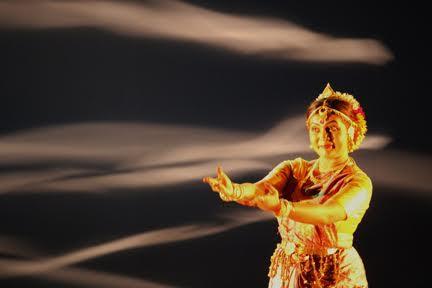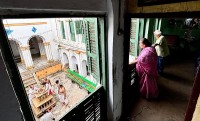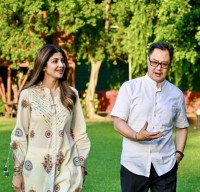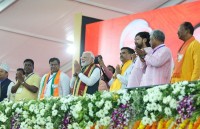 Image
Image
Gaudiya Nritya dancer Satabdi Acharyya talks about her experiences and the future
Kolkata-based dance group Mitrayan, in association with two other groups Bikramshila and Gaudiya Nritya Bharati, presented recently at the Kala Mandir, Kolkata Tamaso Ma Jyotirgamaya a Satabdi Acharyya dance production conceived and based on the importance of the journey from darkness to light, as presented in the Upanishads and in the works of Rabindranath Tagore. The dance style included Gaudiya Nritya with a touch of Kuchipudi and Kathak, various folk dance forms of Bengali, Japanese folk dances and contemporary styles. Shortly after this presentation, Supriyo Hazra spoke to Satabdi Acharyya.
When did you start dancing?
I started my training in Bharatanatyam at the age of 5 years, and, at the age of 8 years, I started my training in Gaudiya Nritya, and still continue to be trained as I believe that there's no end to it.
How has been your experience in the world of dancing?
When you have a guru like Prof. Mahua Mukherjee, who is more like a mother, you emerge not only as a good performer and teacher, but also as a down-to-earth and honest artist. Support from my family has helped me to come out of difficult situations in life. I have also experienced the ugly side of competitions among peers.
.jpg) Can you share with us any special memory that you cherish as a dancer, and keep close to your heart, for the past several years since you started your journey in the world of dancing?
Can you share with us any special memory that you cherish as a dancer, and keep close to your heart, for the past several years since you started your journey in the world of dancing?
Bringing a smile on my parents' faces, and seeing them being proud of their daughter on certain occasions is always memorable. I remember that after a performance in the Nadia district of West Bengal, a very poor and old lady clad in a tattered saree gave me a one rupee coin as her blessing… I still have it with me. After my performance as Prakriti in Rabindranath Tagore's dance drama Chandalika, my guru came and hugged me and went on crying for nearly 5 minutes; her tears said everything. Another memorable occasion was when, after my performance of Chandi Vandana in Bangladesh, some people addressed me as ‘Devi’ or ‘Goddess’, and tried to take my blessings; it was a little embarrassing for me.
During your early years in the world of dancing, who were your inspirations as dancers?
My guru Prof. Mahua Mukherjee, Guru Dhananjayan, a great Bharatanatyam performer, and many other talented and dedicated dancers whom I have seen performing at several dance festivals.
Were you happy with your performance at the Kala Mandir in May?
Yes, I was satisfied, though I am never happy with my own performance as I always feel I can do better. But I am really pleased with my group's performance… they have done a wonderful job.
.jpg) Today, after so many years, how do the reactions of the audience motivate you?
Today, after so many years, how do the reactions of the audience motivate you?
According to me, a performer has no existence without her audience. The audience's reaction is prized above money and everything else. I am addicted to that sound of applause; it is my ultimate degree, award and remuneration.
As a performer of Indian dance forms, do you feel that Indian youngsters are moving away from such arts in this age of smartphones and Internet?
Yes, I agree that the youngsters are moving away from classical dance and music, thanks to the numerous reality shows on TV, the excessive usage of smartphones, etc. What a pity that they remain unaware of India's rich cultural heritage. Despite all these distractions, there is a percentage of young classical dancers who have been lucky enough to have parents who have developed their interest in this field.
How do you want to contribute to the world of dance in future?
As a Gaudiya Nritya dancer, I would like to popularize this rich dance form of Bengal all over the world through my performances, and open up new avenues in Gaudiya Nritya for youngsters with my research work.
As a teacher, what steps do you feel should be taken by the Government and other organizations to attract more and more children towards learning dancing, and concentrate not only on their study books and syllabus?
Our Government has introduced several scholarships and fellowships in the fields of classical and folk dances, but not many are aware of these schemes. Sometimes, deserving candidates are deprived of these scholarships due to the lack of information and of proper judgement. The Government should not only introduce more such schemes, but also look into the process of popularizing them and selecting proper judges according to their qualifications and experience.
Your upcoming projects?
My next project would be Indianising a comedy of Shakespeare, and interpreting it in the language of dance.
Top Headlines
-
News
Horror in Bangladesh: Hindu man lynched and set on fire amid violent protests
December 19, 2025
-
News
Buried at home: UP man arrested for killing wife, two daughters over burqa dispute
December 18, 2025
-
News
Sona College of Technology: Many academic, research and industry-linked advances in 2025
December 17, 2025
-
News
Kolkata: ICCR hosts 10th anniversary celebration of Robir Kiran
December 14, 2025
-
News
Sydney's Bondi Beach horror: Pakistani-origin man named as one of thekeysuspects
December 14, 2025
-
News
Abba Aur Main: Ek Anokhi Dastan Urdu Translation of Neelima Dalmias Memoir Launched at New Delhis Jashn-e-Rekhta Festival
December 14, 2025
-
News
Jaipur: Cultural activist Sundeep Bhutoria calls for Social Investment Policy for Non-resident Rajasthanis at Pravasi Rajasthan Divas
December 14, 2025
-
News
Shashi Tharoor on guest list of Putin State dinner; Rahul Gandhi, Kharge not invited
December 05, 2025
-
News
Putin launches RT India Kremlin-funded RT Network's India arm with 100-member team
December 05, 2025
-
News
Inside Putin's India visit: You wont believe what's on the agenda!
December 04, 2025





